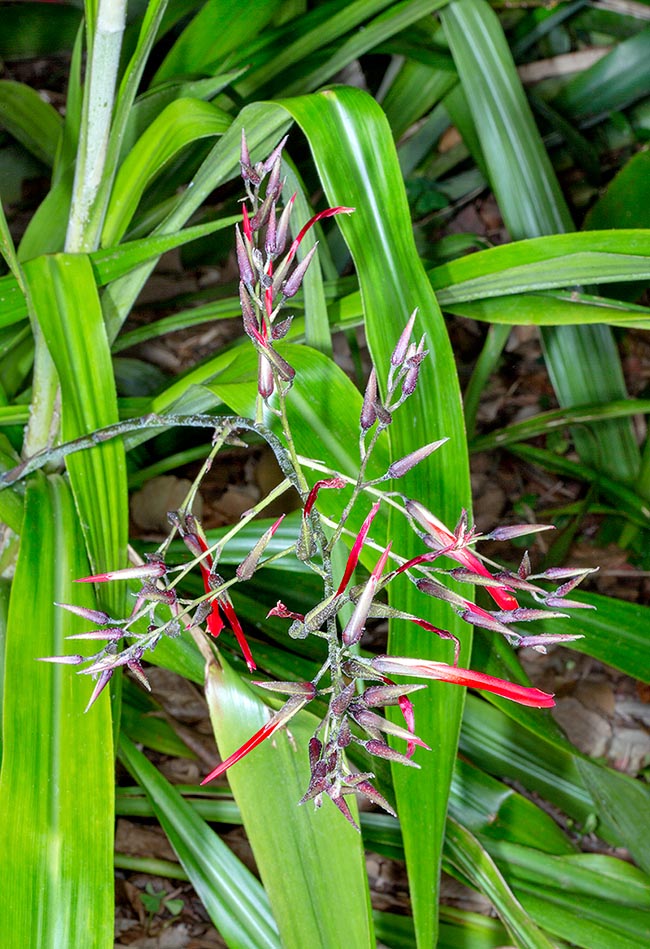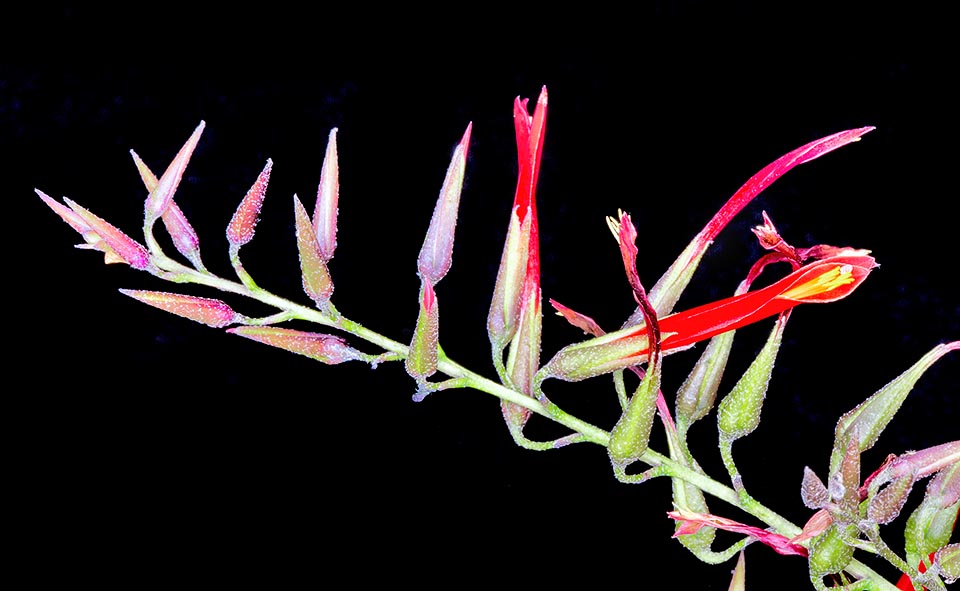Family : Bromeliaceae

Text © Pietro Puccio

English translation by Mario Beltramini

Native to Peru, Pitcairnia pulverulenta is a terrestrial species not exceeding, when in bloom, the 2 m of height © Giuseppe Mazza
The species is native to Peru where it grows in the forests between 600 and 2400 m of altitude.
The genus is dedicated to the English physician Williams Pitcairn (1711-1791), lover of botany and collector of exotic plants in whose greenhouses was described the type species; the name of the species is the Latin adjective “pulverulentus, a, um” = dusty, due to the dust covering the various parts of the plant.
The Pitcairnia pulverulenta Ruiz & Pav. (1802) is a terrestrial evergreen herbaceous species, cespitose, monocarpic (that fructifies one time only and then dies), tall, when in bloom, up to more than 2 m.
Numerous leaves, on a grooved petiole having spiny margins, imbricate, ensiform, 1-1,25 m long and 2,5-4,5 cm broad, with acuminate apex and margins equipped with tiny curved blackish spines, of intense green colour, longitudinally plicate and above glabrous, covered by a waxy dust whitish below.
Erect floral scape covered below by imbricate ovate bracts with acuminate apex and margin provided of tiny curved spines, above by a whitish waxy dust, 25-30 cm long and 1,8-2,5 cm broad.
Inflorescence, up to 1,2 m long, formed by a compound raceme, that is, formed by more racemes departing from a central axis, with the single racemes subtended by bracts similar to those of the scape of length decreasing towards the apex.
Tubular hermaphroditic flowers, on a 0,6-1 cm long pedicel, subtended by an ovate-lanceolate bract with acuminate apex, 0,3-0,5 cm long, covered by whitish waxy dust. Calyx having 3 linear-lanceolate sepals with acuminate apex, 1,5-1,8 cm long, covered by thick whitish waxy dust, corolla with 3 oblong-linear petals with acute apex, 3,5-4 cm long of bright red colour, 6 stamens, arranged in two series of 3, having the same length as the petals, and semi inferior ovary.
The fruit is a trigonal capsule containing numerous brown small seeds. After blooming, the plant stops growing and after a rather long time dries up, but in the meantime has produced new vegetations at the base forming in the time big tufts.
It reproduces by seed, put superficially in porous and draining loam maintained humid at the temperature of 22-24 °C, and by division.

The inflorescence is a compound raceme, with tubular hermaphrodite flowers, bright red corolla and 6 yellow stamens as long as the petals © Giuseppe Mazza
Species present almost exclusively in botanical gardens and in lovers’ collectors, may be employed in open air in the gardens of the zones with tropical and subtropical climate characterized by high environmental constant humidity, in full sun or in partial shade, on substrata rich of organic substance, porous and draining.
Cultivable also in container, fairly capacious due to the size it can reach, to be sheltered in a protected environment, where the climate does not allow the outdoor stay during the winter months, with temperatures not under the 14 °C and environmental humidity of the 65-80 %. If this is not sufficient and the temperature is high, recourse may be done to nebulizations using non calcareous water at local temperature. Frequent watering in summer, but without stagnations, rather spaced in winter in order to allow the substratum to dry up in surface.
Synonyms: Orthopetalum pulverulentum (Ruiz & Pav.) Beer (1856); Hepetis pulverulenta (Ruiz & Pav.) Mez (1896).
